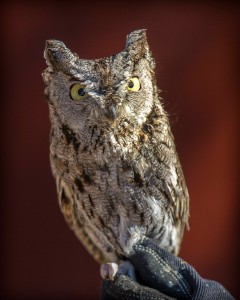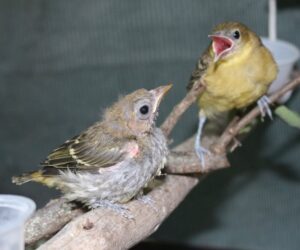
Hooded Oriole (right) fledglings.
Songbirds
The WR&R Songbird Team rehabilitates over 80 species of injured, ill, or orphaned birds. Most of these species are songbirds. Songbirds are members of the largest group of birds called “passerines” due to their ability to perch with strong feet. Songbirds are able to sing and make more complex sounds than other kinds of birds due to the anatomy of their syrinx. There are many kinds of passerines such as flycatchers, jays, robins, finches, swallows, warblers, blackbirds, and wrens. The largest and perhaps most intelligent songbirds are crows and ravens. In addition to passerines, the Songbird Team cares for other native birds such as doves, woodpeckers, and hummingbirds.What To Do If You Find An Injured Bird
If you have found a bird that needs help, before taking any action, call the WR&R answering service (530) 432-5522. Until you receive a call back, if the bird is in any distress, you can capture it and place it in a box no larger than twice the size of the bird. If it’s a baby bird, see below. You will be asked several questions and will be given advice on what to do. During transport to a rehabilitator or to our center, please keep noise and conversation at a minimum to reduce the bird’s stress.Cat-Caught Birds
Sadly, free-roaming cats are the cause of many birds requiring help. Any bird that was in the mouth or near a cat or dog must be brought in for examination. Cats and some dogs carry deadly bacteria in their saliva. Punctures from bites or claws introduce the bacteria into the bird. The skin of the bird closes quickly so you may mistakenly believe your cat/dog did not harm the bird. Many cat-caught or dog-caught birds suffer from crushing injuries that you also cannot see. Unfortunately, many do not survive and die a slow death from their attack. They must be placed on a 7-10 day course of antibiotics.Collision With Windows or Cars
These victims must be brought in for examination and observation for at least 24 hours. Birds suffer concussions just like people and sometimes the brain continues to swell after the initial impact. Some birds that hit an object may be able to fly away, but later die from their injuries nowhere near where it happened. Place the bird in a box (no larger than twice the bird’s size), secure the lid and get it to a professional a.s.a.p.BABY BIRD CARE / TEMPORARY CARE INSTRUCTIONS
Should it be out of the nest? See below “To Rescue or Not” Warm the bird: if the baby feels cold it needs to be warmed immediately. You can wrap the baby in a small piece of fleece while getting a “nest” ready and the heating pad is warming on low. Conversely, if it is hot outside and the baby was exposed too long and feels too hot, it must cool down before placing on a heating pad. Once the bird’s temperature has been stabilized, monitor it by feeling the bird. Make a nest: If the baby bird does not have feathers or still has bare areas, this is probably a nestling. First make a nest with soft tissue inside a container (so the bird is snug inside the tissue). Place container on a heating pad set on low. The bird should feel warm to the touch. Adjust heat by placing layers of cloth between the nest/container and the heating pad. Place in a small area like a bathroom away from children, pets, and excessive noise. Hydration: If you cannot get the baby bird to a rehabilitator within an hour or two, it will need hydration. This is best done by an experienced rehabilitator. Baby birds are never given food before we are sure their guts are working. NEVER squirt water into a bird’s mouth! The opening to their lungs is at the base of the tongue and you will drown the bird. Fresh or thawed frozen blueberry pulp is safe. Mash and offer with a blunt stick (coffee stir or popsicle stick). Warm, plain Pedialyte or plain water can be applied to the tip of the beak with a moistened Q-tip. If the baby feels lethargic and has not pooped, it needs moisture to get the guts moving. Temporary/Emergency Food: ALL BIRDS SHOULD BE CORRECTLY IDENTIFIED BEFORE FEEDING AND THE BIRD’S GUTS MUST BE WORKING FIRST (see hydration above). However, if you cannot get advice from a professional or the bird cannot be taken to a rehabilitator for several hours, the baby bird must eat something. The internet is loaded with deadly misinformation so do NOT google “WHAT TO FEED A BABY BIRD.” Most baby “song” birds must be fed at least every 30 minutes until they can get professional help.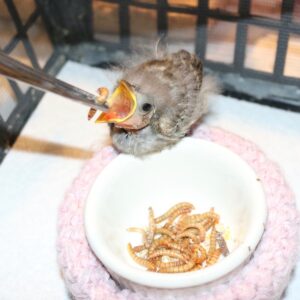 The following diet is an EMERGENCY FOOD ONLY, not what we provide baby birds daily:
Most baby birds are fed insects by their parents. Small mealworms or cricket bodies (no legs/wings) can be offered. They can be dipped in water for extra moisture. Finches are fed tiny seeds by their parents but a few insects to get by will not harm them.
DO NOT FEED THE FOLLOWING: Do not feed Earthworms used for bait, they can cause sickness or death. Although many birds eat earthworms, many cannot digest them. A few earthworms or redworms from an organic garden can be fed to robins, bluebirds, and jays.
Do not feed pet food (with few exceptions). Some omnivorous (plant & meat eating) birds like jays and robins, can be fed soaked (soggy) kitten food. Other birds like wrens, swallows, and other truly insectivorous birds will die if fed pet foods!
Never give milk or any dairy product.
Never give raw hamburger or chicken.
Do not feed “Exact” by Kaytee: the ONLY baby birds that can tolerate a grain-based diet are finches, pigeons, and doves. Exact should NEVER be fed to other kinds of baby birds that require higher amounts of protein in the form of insects, rodents, etc.
Soiled Feathers: Do NOT get food on feathers. It can damage the feathers and cause a bird to be non-releasable. Gently clean beak & feathers with a moistened soft tissue or Q-tip. Be careful – they are very sensitive. Do NOT give the bird a bath!
To Rescue or Not – Should it be Out of the Nest?
If the baby bird is naked or mostly naked, bare areas still are observable, it should not be out of its nest. If it has some adult-like feathers, it still may be too young. If it cannot move, it is too young or may be injured. If there are no parents tending to it, it cannot feed or defend itself. If no parents have come to feed the baby after 60-90 minutes, it may need help.
Is the baby bird abandoned? Parent birds rarely “abandon” their young. Sometimes both parents are killed. If one parent is missing, this may be normal for the species (such as hummingbirds). In most cases, it will be difficult for one parent to brood, feed, and defend the young. Careful observation is needed to determine if the babies are truly orphaned. Older nestlings or near-fledglings are fed less often. Parents are sneaky as they come and go as they do not want to alert predators. If a baby bird is continuously making sounds, it is probably in trouble.
Fledglings: are baby birds that have left their nest because they are ready. But they are still dependent on their parents for food and protection for a few days to weeks after fledging. Some fledglings, such as cavity (tree or box) nesters usually fly fairly well at first. They should NOT be on the ground and need help. Others need more time to hone their flying skills, so they are often found on the ground or in bushes. If they are not in any danger (cats, dogs, children, parking lot, etc.) they should be left alone for parents to tend to them. If the bird is strong enough to perch on your finger, find the nearest vegetation for protection.
Renesting: it is ideal to speak with a professional before attempting to replace a baby bird back in its nest. There are many reasons young birds come out of their nest early. A naked baby bird that has accidentally come out of its nest is usually found below the nest. If you cannot find a nest, it may be a cavity-type nester. If it’s found nowhere near a nest it may have been dropped by a predator. Also, unhealthy baby birds may intentionally be removed by the parent. If you have located the nest, the bird may be able to be replaced if it is not injured or has not been exposed to the elements too long. Caution! Near-fledglings (fully feathered nestlings) have a strong fear response and putting a bird back, can cause remaining siblings in the nest to jump early. Also, if a cat or squirrel has discovered the nest, putting the baby back can result in its death.
Second nest or replacement nest: If the original nest is intact, DO NOT make a second (separate) nest for a baby bird. The mother bird cannot possibly keep the baby warm, and the parents will not feed it. If a nest is destroyed and the babies are unharmed, a replacement nest can be made. The replacement nest should be secured near the original nest location with adequate amount of cover for concealment. If you cannot spend time observing to see if the parents return, then it’s best not to leave the baby birds.
Replacement nest: a small basket or plastic cup (with holes drilled in the bottom to allow air and drainage). Line with tissue to keep babies snug inside. Baby bird must be able to back up and defecate over the edge.
Moving a nest: it is illegal to touch a nest with eggs or young. If you find a nest on a vehicle or boat that you need to use, please call a professional for advice before doing anything.
The following diet is an EMERGENCY FOOD ONLY, not what we provide baby birds daily:
Most baby birds are fed insects by their parents. Small mealworms or cricket bodies (no legs/wings) can be offered. They can be dipped in water for extra moisture. Finches are fed tiny seeds by their parents but a few insects to get by will not harm them.
DO NOT FEED THE FOLLOWING: Do not feed Earthworms used for bait, they can cause sickness or death. Although many birds eat earthworms, many cannot digest them. A few earthworms or redworms from an organic garden can be fed to robins, bluebirds, and jays.
Do not feed pet food (with few exceptions). Some omnivorous (plant & meat eating) birds like jays and robins, can be fed soaked (soggy) kitten food. Other birds like wrens, swallows, and other truly insectivorous birds will die if fed pet foods!
Never give milk or any dairy product.
Never give raw hamburger or chicken.
Do not feed “Exact” by Kaytee: the ONLY baby birds that can tolerate a grain-based diet are finches, pigeons, and doves. Exact should NEVER be fed to other kinds of baby birds that require higher amounts of protein in the form of insects, rodents, etc.
Soiled Feathers: Do NOT get food on feathers. It can damage the feathers and cause a bird to be non-releasable. Gently clean beak & feathers with a moistened soft tissue or Q-tip. Be careful – they are very sensitive. Do NOT give the bird a bath!
To Rescue or Not – Should it be Out of the Nest?
If the baby bird is naked or mostly naked, bare areas still are observable, it should not be out of its nest. If it has some adult-like feathers, it still may be too young. If it cannot move, it is too young or may be injured. If there are no parents tending to it, it cannot feed or defend itself. If no parents have come to feed the baby after 60-90 minutes, it may need help.
Is the baby bird abandoned? Parent birds rarely “abandon” their young. Sometimes both parents are killed. If one parent is missing, this may be normal for the species (such as hummingbirds). In most cases, it will be difficult for one parent to brood, feed, and defend the young. Careful observation is needed to determine if the babies are truly orphaned. Older nestlings or near-fledglings are fed less often. Parents are sneaky as they come and go as they do not want to alert predators. If a baby bird is continuously making sounds, it is probably in trouble.
Fledglings: are baby birds that have left their nest because they are ready. But they are still dependent on their parents for food and protection for a few days to weeks after fledging. Some fledglings, such as cavity (tree or box) nesters usually fly fairly well at first. They should NOT be on the ground and need help. Others need more time to hone their flying skills, so they are often found on the ground or in bushes. If they are not in any danger (cats, dogs, children, parking lot, etc.) they should be left alone for parents to tend to them. If the bird is strong enough to perch on your finger, find the nearest vegetation for protection.
Renesting: it is ideal to speak with a professional before attempting to replace a baby bird back in its nest. There are many reasons young birds come out of their nest early. A naked baby bird that has accidentally come out of its nest is usually found below the nest. If you cannot find a nest, it may be a cavity-type nester. If it’s found nowhere near a nest it may have been dropped by a predator. Also, unhealthy baby birds may intentionally be removed by the parent. If you have located the nest, the bird may be able to be replaced if it is not injured or has not been exposed to the elements too long. Caution! Near-fledglings (fully feathered nestlings) have a strong fear response and putting a bird back, can cause remaining siblings in the nest to jump early. Also, if a cat or squirrel has discovered the nest, putting the baby back can result in its death.
Second nest or replacement nest: If the original nest is intact, DO NOT make a second (separate) nest for a baby bird. The mother bird cannot possibly keep the baby warm, and the parents will not feed it. If a nest is destroyed and the babies are unharmed, a replacement nest can be made. The replacement nest should be secured near the original nest location with adequate amount of cover for concealment. If you cannot spend time observing to see if the parents return, then it’s best not to leave the baby birds.
Replacement nest: a small basket or plastic cup (with holes drilled in the bottom to allow air and drainage). Line with tissue to keep babies snug inside. Baby bird must be able to back up and defecate over the edge.
Moving a nest: it is illegal to touch a nest with eggs or young. If you find a nest on a vehicle or boat that you need to use, please call a professional for advice before doing anything.
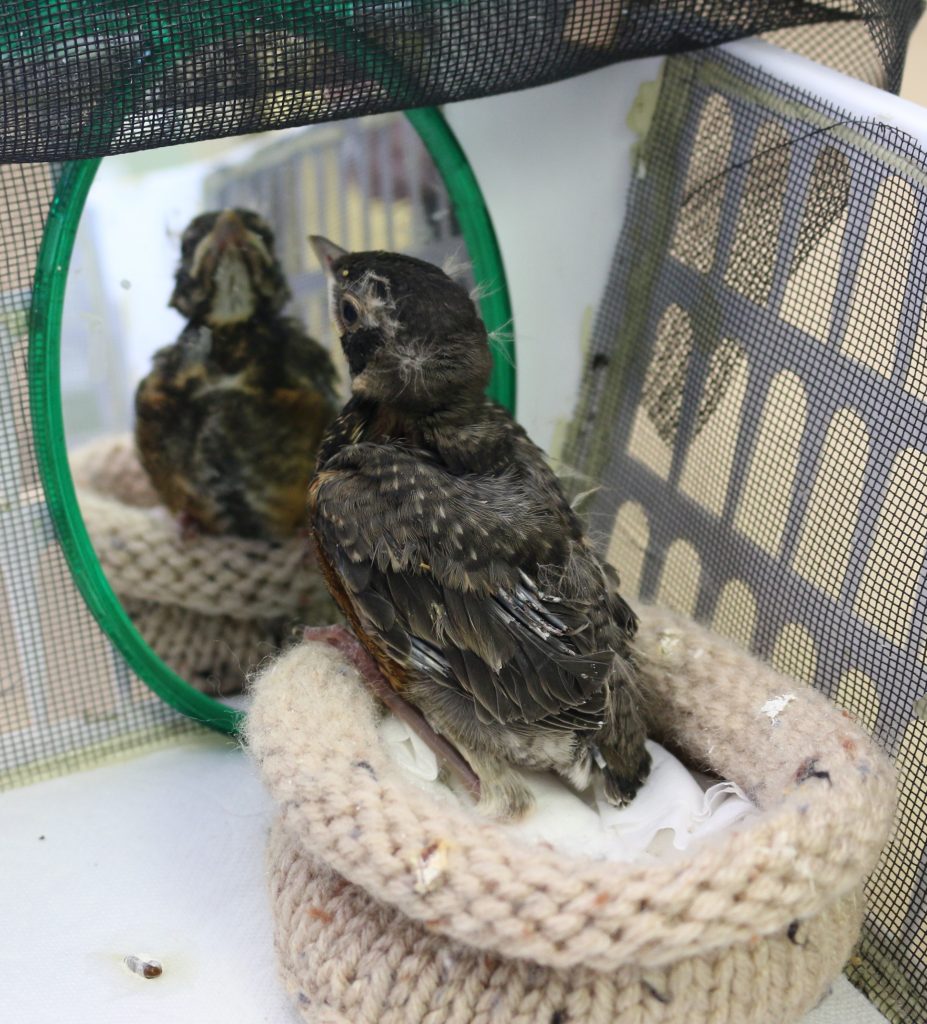 Symptoms of illness or injury:
Symptoms of illness or injury:
- Cannot stand; falls over
- walks with limp
- Cannot flap wings
- wing droops or tilts upward
- Tail cocked to one side (possible spinal injury)
- Weak, shivering, puffed up, not moving Bleeding (an emergency) Fully feathered bird sits with eyes closed Eyes crusted over
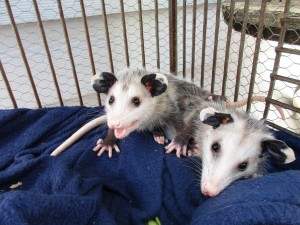 Small Mammals
Small Mammals
Guidelines for Handling Sick, Injured or Orphaned Native Wildlife
We do not recommend members of the public handle wild animals, however there are times when it is the only way to get an animal the help it may need. If you must confine an injured or orphaned animal:- Heavy leather gloves are necessary for handling mammals.
- Wash your hands immediately before and after handling the animal.
- Do not give the animal any food or water (except hummingbirds–see below)
- Line an escape proof, ventilated box, animal carrier or similar type container with old t-shirts or soft cloths (not terry cloth which can catch on toenails or claws). Place the animal in the box, cover the container with a light sheet or towel, and put it in a warm, dark, quiet place away from pets and children until you can get it to a wildlife center or are able to connect with a small mammal team volunteer. If traveling with the animal in the car, please no talking, car radios or smoking to minimize additional fear.(no talking or car radios!).
- An injured or sick animal will likely be in shock or may be chilled from exposure. Wrap a hot water bottle in a towel and place it inside the container next to the animal. Or if able, place a heating pad under half the container until a small mammal volunteer arrives.
Animals Trapped in the House or Garage
- Open a door or window to the outside and close off any doors to other rooms.
- Leave the animal alone in the dark and quiet, and it will probably find its way out.
Injured Animals in Roads or Yards
- Do not give the animal any food or water. An animal that is chilled or dehydrated cannot process food. Feeding it or giving it water could compromise it further and lead to its death.
- Keep the box in a dark, quiet place, away from people and pets!
Small Mammal Guidelines
We have many different species of mammals in our area, including those not normally seen as they are nocturnal or extremely shy or rare. These include flying squirrels, ringtail cats, otter, beaver, and more. Below are descriptions of the more common small mammals.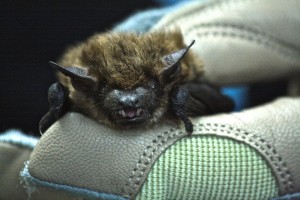 Bats
Bats
- A bat is a mammal – the only one with true flight.
- Bats can see about as well as we see and they use echolocation.
- There are about 1,100 species of bats in the world – that is almost 25% of all mammal species. There are 45 species in the US, 24 in CA and about 16 species that live or migrate through the Northern California valley, foothills and mountains. All our bats eat insects.
Never Handle a Bat with Your Bare Hands!
A bat is a wild animal. When it is picked up it will bite. Bats are small, so when they are on the ground, people tend to approach them. When they are sick or injured a bat often lies quietly and looks calm until they are touched, then they will try to protect themselves. Humans should never touch a bat without protecting themselves. We wouldn’t pick up an injured or sick raccoon or feral cats without protecting ourselves, but somehow people don’t stop and think about the dangers of being bitten by a bat. If the bat is touched with bare hands, the bat must be tested for rabies; this means the bat will need to be killed. If the bat escapes, the person should contact their health provider to evaluate the need for rabies vaccination. Many animals do not show symptoms of rabies until the disease has progressed. Signs and symptoms vary between species. Generally bats do not become ferocious when they display signs of rabies. They don’t foam at the mouth, or have other symptoms for which we are more familiar. Just because a bat is not acting vicious doesn’t mean it’s not sick. For more information see the CDC website.
IF THE BAT IS FLYING INSIDE THE HOME, open the doors or windows. Turn inside lights out and turn on outside lights. The bat will follow the bugs which are attracted to the light.
- If this doesn’t work and you are sure no human contact has occurred:
- Wait until the bat is motionless. Move slowly and calmly.
- Cover the bat with a box or container. Contact NorCal Bats at 530-902-1918.
- If the bat must be moved, wear heavy gloves for your safety and the safety of the bat. Use a small box or coffee can and a piece of cardboard to scoop the bat into a box or other small container.
- Place a cloth such as t-shirt material (nothing with loops that can catch the bat’s toes) in the box to give it a place to cling and hide. Water can be offered by placing it in a very shallow container (like a baby food jar lid).
- Make sure the box with the bat is safe from predators, pets and children; in a calm, quiet place, out of the direct sun.
- Contact NorCal Bats at 530-902-1918 (don’t send e-mail for a rescue) or the California Department of Fish & Game for a wildlife rehabilitator in your area.
- Do not attempt to rehabilitate the bat on your own or try to keep it as a pet. Bats have very specific dietary and environmental requirements. A trained rehabilitator will be familiar with the needs of the various bat species. Also, it is not legal to keep any wildlife as a pet.
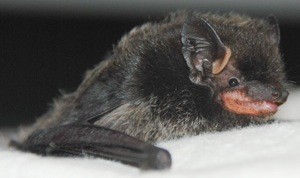 Bat Facts
Bat Facts
- Most bats eat insects including some disease-causing and crop-eating insects. The insect-eating bats help to reduce illness, crop loss and the use of poisonous pesticides on food.
- Loss of bats destabilizes ecosystems and increases our reliance on chemical alternatives which often threaten both environmental and human health.
- Worldwide, bats play essential roles in keeping populations of night flying insects in balance.
- Desert ecosystems rely on nectar feeding bats as primary pollinators of giant cactus.
- A red bat that eats 100 moths may prevent egg-laying that would produce 25,000 new caterpillars that could attack farmers crops.
- One little brown bat can catch 1,200 bugs in an hour, often two in a single second. A nursing mother eats more than her own body weight nightly – up to 4,500 insects, including pests such as mosquitoes.
- The largest bat in the world is the Giant Flying Fox found in Malaysia with a 5 1⁄2 foot wing span, the largest in the US is the Western Mastiff with a 2 foot wing span
- The smallest bat in the world is the Bumblebee Bat found in Thailand with a 6 inch wing span, in the US the Western Pipistrelle with an 8 inch wing span.
- Bats are exceptionally vulnerable to extinction, in part because they are the slowest reproducing mammals on earth for their size, most produce only one young annually. Also, many species live in large colonies where one attack can kill thousands, even millions.
- More than 50% of American bat species are endangered or declining sufficiently to warrant special concern.
 Bobcats
Bobcats
The bobcat is one of two species of lynx found in North America. They weigh 15 to 35 pounds, are larger than domestic cats and have a short, black-tipped tail. Their ears have long black tufts or fur at the tips. Bobcats prey upon rodents, rabbits, carrion and insects and are therefore useful to landowners. Bobcats can inflict serious bites, however, and should not be handled by the untrained public. If you find one injured, contact Wildlife Rehabilitation & Release, 530-432-5522 for assistance.
To avoid problems with bobcats:
- Do not feed pets outdoors. If you must feed outdoors, clear away food bowls immediately. Do not leave food out at night.
- Ensure that any pets that could be considered prey (rabbits, etc.) are securely housed.
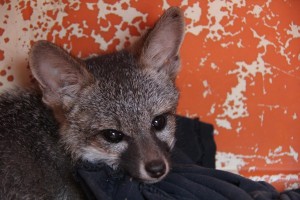 Coyotes/Foxes
Coyotes/Foxes
Coyotes are members of the dog family and weigh between 20 and 50 pounds. They are gray, brown or tan above and whitish underneath. Coyotes eat garbage, insects, rodents, rabbits, birds, deer, fruits and berries. They are normally solitary hunters and are important to controlling rodent populations.
Gray foxes are members of the dog family and weigh between 8 and 15 pounds. They have silvery gray fur, a black-tipped tail, and reddish fur on their chest and legs. Gray foxes are opportunistic hunters that eat plant matter, fruit, rodents, hares, and insects. They are most active at night, dawn, or dusk. During the day, they retreat to their den, which is usually in a hollow tree or burrow.
If you find an injured fox or coyote, contact Wildlife Rehabilitation & Release, 530-432-5522 for assistance. These species can inflict serious bites and should not be handled by the untrained public.
To avoid problems with foxes and coyotes:
- Do not feed pets outdoors. If you must feed outdoors, clear away food bowls immediately. Do not leave food out at night.
- Keep pets indoors when coyotes are seen or heard.
- Do not feed coyotes or foxes.
- Use noise to discourage them.
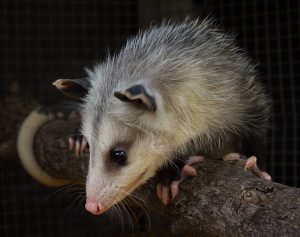 Opossums
Opossums
There are more than 60 different species of opossum, which are often called possums. The most notable is the Virginia opossum or common opossum— the only marsupial (pouched mammal) found in the United States and Canada.A female opossum gives birth to helpless young as tiny as honeybees. Babies immediately crawl into the mother’s pouch, where they continue to develop. As they get larger, they will go in and out of the pouch and sometimes ride on the mother’s back as she hunts for food. Opossums may give birth to as many as 20 babies in a litter, but fewer than half of them survive. Some never even make it as far as the pouch.
- Opossums are scavengers, and they often visit human homes or settlements to raid garbage cans, dumpsters, and other containers. They are attracted to carrion and can often be spotted near roadkill. Opossums also eat grass, nuts, and fruit. They will hunt mice, birds, insects, worms, snakes, and even chickens.
- These animals are also very useful to have around. They are the ground version of the vulture, cleaning up carrion. Opossums act like little vacuum cleaners when it comes to ticks, including those that can spread lyme disease.
- Opossums are most famous for “playing possum.” When threatened by dogs, foxes, or bobcats, opossums sometimes flop onto their sides and lie on the ground with their eyes closed or staring fixedly into space. They extend their tongues and generally appear to be dead. This ploy may put a predator off its guard and allow the opossum an opportunity to make its escape.
- Opossums are excellent tree climbers and spend much of their time aloft. They are aided in this by sharp claws, which dig into bark, and by a long prehensile (gripping) tail that can be used as an extra limb. Opossums nest in tree holes or in dens made by other animals.
- These animals are widespread and are sometimes hunted as food, particularly in the southern United States. Adult opossum that are injured can be placed in a box or pet carrier by grabbing the base of the tail while wearing heavy leather gloves. Avoid the head and mouth. Opossums are not typically aggressive. You can also use a shovel to gently scoop the animal into a box for transport.
- If an opossum is killed, check the pouch. If there are babies in the pouch attached to the nipples, do not try to detach them. Bring the dead mom with the babies attached to a wildlife rehabilitator; Wildlife Rehabilitation & Release, 530-432-5522. Baby opossums swallow the nipple to help them stay in the pouch, so they are difficult to remove
- If the babies are not attached, please follow the “Guidelines for Handling Sick, Injured, or Orphaned Wildlife at the top of the page and call 530-432-5522.
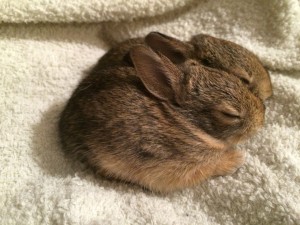 Rabbits and Hares
Rabbits and Hares
Hares and Rabbits are two entirely different species. A Jackrabbit is a Hare while a Cottontail or brush rabbit are truly rabbits. Jackrabbits are born at about 80 grams, with their eyes open, fully furred and able to move and hop around their nest. Cottontails are born at about 30 grams with their eyes closed (they open at 7-10 days old), completely naked and dependent on their mother. I’ve included pictures to help with identification.
- Cottontails build a nest, which is a shallow depression in the ground, usually next to a building, under a woodpile or even a burrow underground, and have all their “kits” (baby rabbits) in that nest. Whereas, Jackrabbits may have four “leverets” (baby jackrabbits), usually in an open field or grassy area. The mother may put one baby in one area, two somewhere else and another in a third spot. This way, predators won’t get the whole litter and all will be in range for her to care for them.
Cat-Caught Cottontails
If your cat brings you a cottontail kit, it’s likely it’s found the nest and will be back with more, one at a time. Please, don’t punish your cat for bringing you the kit or your cat will stop bringing them and we can’t save them if they’re hidden by a fearful cat. Cat-caught animals need to be administered antibiotics to counteract the toxins in cat saliva.- If you see a nest of either species and are able to leave them there but want to know if mom is caring for them, you can put foliage lightly in front of any openings or make an X with string, then check in 12-18 hours later to see if mom’s been there and moved things around getting
- to her babies. Both species only feed their young 1-2 times daily. Their milk is one of the most nutritious of all mammals. If there’s no sign of mom being there within 18 hours, call WR&R Hotline immediately – 530-432-5522. Hares/Rabbits have such a high metabolism, they can’t go as long as other species without food. If you’re not sure, call us. We will come and check the babies. If they’re fine, you can watch them grow up where they are. If not, we will raise them and bring them back for release. It’s a myth that the mother won’t return and care for her babies if there’s human scent on them. Mom will continue with her job. She will only be spooked off if she continuously sees humans at her nest; make no mistake, she’s watching.
- Both species are very fragile, more than any other mammal species we deal with. Stress alone will kill them. It is very important to get them to an experienced rehabber as soon as possible. Until then, put them in a dark, quiet place without the sounds of dogs, kids, television or anything unnatural. Avoid handling; their backs are very fragile. Even a newborn can break it’s back struggling when handled.
- Please, do not try to give them medications. Most medications that are used with other mammals are toxic to rabbits/hares. Trained small mammal rehabilitators have the supplies and medications to care for them properly, to give them their best chance of survival and to be reintroduced back to their homes.
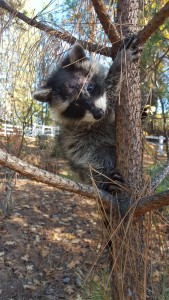 Raccoons
Raccoons
Raccoons are familiar animals with masked faces and ringed tails. They have five toes on both the front and hind feet. Their long, dexterous fingers enable them to open latches, untie knots, turn doorknobs, and open jars. Their prints look like tiny human baby handprints and footprints.
- They are primarily nocturnal and thrive in many cities as well as wilderness areas. In fact, the densest population of raccoons in New York is in New York City. They are very intelligent and adaptable animals.
- They are omnivorous and eat a variety of foods, including frogs, fish, amphibians, shellfish, insects, birds, eggs, mice, carrion, berries, nuts, vegetation, salamanders, insects, berries, corn, cat food, and human garbage.
- Their tracks are commonly found near water. Where you find water, you find mud, which is an excellent medium for studying tracks. The hind feet in the picture on the left sunk deeper into the mud due to the heavier hind end of the raccoon’s body. It is widely believed that raccoons always “wash” their food. This is not true. They exhibit a behavior called “dabbling” in which they dunk their food in water. This helps enhance their sense of touch and helps them find food underwater by feeling with their sensitive fingers. It also enables them to sort out items that are not edible.
- During cold weather, raccoons will sleep for several days, but do not hibernate.
Baby Raccoons
If the baby raccoon has been seen alone for more than a few hours, he’s probably been orphaned. Mother raccoons closely supervise their young and don’t let them out of their sight. If the baby raccoon is safe from dogs and other predators, you can put an upside-down laundry basket over the baby (with a weight on top) and monitor him for a few hours. The mother will not return if people or pets are nearby, so stay clear and keep pets away, giving the mother a chance to reclaim her baby. If the baby is cool or cold, it should be warmed before placing out for reclaiming. Place a hot water bottle under the towel the baby is resting on. Humans handling the baby will not make the mother reject it. If the mother does not return in a few hours, contact Wildlife Rehabilitation & Release, 530-432-5522. Injured baby raccoons should be brought in immediately.Injured Adult Raccoon
Do not touch an injured adult raccoon! Contact your Animal Control or WRR immediately! or 530-432-5522. Most injured animals will fight even harder because they are scared. Mammals such as foxes, skunks, bats, coyotes and others are called vector species. This means they have the potential to carry rabies. If you have no other choice, here is what you need to handle an injured animal – if you are certain that the animal was injured versus being sick:- Very thick gloves
- Blanket
- A pet carrier or a container with lid and air holes
- Remember – safety first!
To avoid problems with raccoons:
Do not feed pets outdoors. If you must feed outdoors, clear away food bowls immediately. Do not leave food out at night.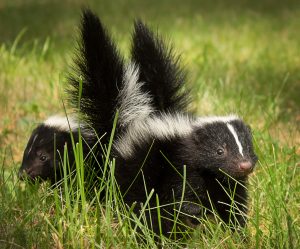 Skunks
Skunks
Skunks are members of the weasel family (Mustelidae). Skunks tend to den in shallow burrows or hollow logs. They are hardly ever found more than two miles from a water source. In urban territories, skunks den beneath buildings, decks, dumps, and woodpiles. They are capable of burrowing a den a foot or so underground, with well-hidden entrances. They like warm, dry, dark, and defensible areas; most house basements and crawl spaces qualify.
Skunks are generally nocturnal and begin foraging at sunset. Skunks are omnivorous and help keep the rodent population in check. They often travel five to ten miles within their territory at night looking for field mice and other small rodents as well as lizards, frogs, birds, eggs, garbage, acorns, and fallen fruit. They also dig for insects, especially beetles, larvae, and earthworms. Their diet includes black widow spiders and scorpions. Being carrion eaters, they help keep roadways and neighborhoods clean. An estimated 70 percent of a skunk’s diet consists of insects considered harmful to humans.
- The skunk’s chief enemies are automobiles and great horned owls, both of which kill skunks in large numbers. Skunks rarely attack unless cornered or defending their young. If approached by an intruder and unable to flee, a skunk will usually fluff its fur, shake its tail, stamp the ground with its front feet, growl, stand on its hind legs, turn its head and spit to scare the potential attacker. If those techniques do not work, it will lift up its tail and spray.
- The chemical skunks spray at their enemies is a sulfur compound called N- bulymercaptan. It is ejected in a fanlike pattern from two small openings near the animal’s rectum. The glands that produce the chemical hold enough for five or six full-powered sprays, but skunks seldom spray without warning or cause. Although they have sharp teeth, they rarely use them in defense, because their spray is most accurate and effective at a range of up to 15 feet.
- Having adapted well to neighborhoods, it’s not uncommon to find skunks and domestic cats dining peacefully together. There have been cases of skunks entering homes through pet doors, dining with the family cat and finding a quiet closet or empty bed to spend the night. As long as the skunk does not feel threatened, it won’t spray.
- With their slow, waddling gait and bushy tail, these gentle mammals are delightful to see from a distance, and play an important role in keeping nature in balance.
Baby Skunks
If you find abandoned baby skunks, you should phone a rehabilitator first. Often, the baby skunks are not truly abandoned by their mother. If you must move baby skunks, wear rubber gloves first. Baby skunks are easier to handle prior to adolescence, but will spray if they are scared. Skunks can carry rabies. Any skunk large enough to require two hands to pick up is old enough to be on its own.Adult Skunks
The public should not handle an injured adult skunk. Contact your Animal Control or WRR immediately. If you must move an injured adult skunk, use a towel or blanket and wear heavy leather gloves and glasses. Skunks spray when they are frightened; their eyesight is poor. It is important to move slowly. Speak to the skunk in a low voice so that it realizes you are approaching. Slowly and gently place in a box. Cover the box or carrier with an additional towel or blanket.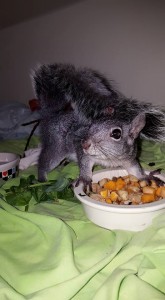 Squirrels
Squirrels
Squirrels are small to medium-sized rodents. In Nevada, Yuba, and Sutter Counties squirrels are common. There are several different kinds including Gray Squirrels, Ground Squirrels, Douglas Squirrels and Flying Squirrels. They are generally clever and persistent animals. In residential neighborhoods they are notorious for eating out of bird feeders, digging in potted plants either to bury or recover seeds, and for inhabiting sheltered areas including attics. While many companies sell bird feeders which are supposedly “squirrel-proof”, very few of them really are. Although expert climbers, and primarily arboreal, squirrels also thrive in urban environments that are largely free of trees.
Urban squirrels have learned to get a great deal of food from over-generous humans. One of the more common and inexpensive foods fed to squirrels is peanuts. Recent studies however have shown that raw peanuts contain a trypsin inhibitor that prevents the absorption of protein in the intestine. Wildlife rehabilitators in the field have noted that neither raw and roasted peanuts or sunflower seeds are good for squirrels, since they are deficient in several nutrients needed. This type of deficiency has been found to cause Metabolic Bone Disease, a somewhat common ailment found in malnourished squirrels. Thanks to its agreeable appearance, intelligence and its eating styles and habits, squirrels are one of the most successful wild urban animal species.
Injured Baby Squirrels
If the baby appears uninjured (no bloody nose, no wounds), and is warm to the touch, place it in a shallow, towel-lined box at the base of the tree and leave it undisturbed for four to six hours. Often, the mother will come down and carry off the baby. She will not come down if people or pets are nearby, so stay clear. If the baby is cool or cold, it should be warmed before placing out for reclaiming. Place a hot water bottle under the towel the baby is resting on. Humans handling the baby will not make the mother reject it. If the mother does not reclaim the baby within three hours, or by dark, bring the infant inside and keep it warm until it can be transported to Wildlife Rehabilitation & Release, 530-432-5522. Injured baby squirrels should be brought in immediately.Injured Adult Squirrels
If you find an injured or sick squirrel (bloody nose, shivering, attacked by cat or dog), place the animal in an escape proof, ventilated box lined with a towel or soft cloth. Wear gloves and wash your hands before and after handling the animal. Cover the container with a light sheet or towel and place it in a warm, dark, quiet place until you can get the animal to Wildlife Rehabilitation & Release, 530-432-5522. Follow the “Guidelines for the Public in Handling Sick, Injured, or Orphaned Wildlife” listed at the top of the page. Note exactly where you found the animal. This will be important for its release.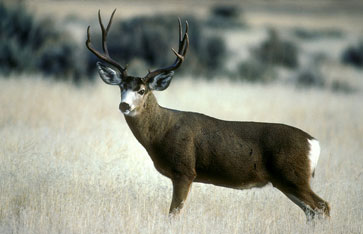 Deer
Deer
If you find an injured adult deer, stay clear of the animal!
Adult deer are very dangerous and have the potential to seriously hurt or kill good Samaritans. Petting and stroking an injured adult deer can kill the animal from stress. They do not find it comforting. Contact your local animal control officer for assistance.
If the deer is merely trapped in someone’s yard, be patient. Deer can usually find their way out of any yard they find their way into. Do not chase the animal. It may panic and injure itself or anyone around it. Never approach an adult deer, especially if it is obviously panicky.
Fawns
Wildlife Rehabilitation and Release does not take in abandoned fawns but they can assist you. Kindred Spirits is the organization that cares for and releases fawns and they are located in Loomis. For information and assistance with fawns in distress, contact Kindred Spirits 530-889-5822. (http://kindredspiritsfawnrescue.org) People often mistakenly assume that a baby deer, called a fawn, is orphaned if found alone. Rest assured that the mother deer, the doe, is probably nearby. The doe will only visit and nurse her fawn a few times a day to avoid attracting predators. Do not remove a healthy fawn from its location. Unless you know the mother is dead, leave the fawn alone. If the baby does not appear injured or sick and is not in immediate danger, then leave the area. The mother will not return if people or pets are present. Mother deer are wary of human smells; DO NOT TOUCH a fawn with your hands. Unlike birds, deer do have a good sense of smell. If you have already
handled the fawn, take a towel, rub it in the grass, and then wipe down the fawn to remove all human scent. Then return the fawn to the place where you found him.
If the fawn looks injured, cold, hungry, diseased, confused, crying incessantly, or if dogs, other animals, people or automobiles threaten its safety, call Kindred Spirits (530) 889-5822, located in Loomis. If you are transporting the animal to a wildlife center, place the fawn in a dog carrier or cardboard box lined with a towel. Cover the carrier with a sheet or towel for transport. Keep it warm and quiet (no radios or talking while driving!). Do not feed the animal.
A bird of prey or raptor is a bird that hunts for food primarily using its talons. Their beak tip is curved and they have superb vision.
If you find an injured adult or young raptor, unable to fly, call WR&R immediately – 530-432-5522. Do not attempt to care for these delicate birds. They have very specific food and care requirements. Not only is it dangerous for the bird, it is illegal.
The following describes some of the raptors found in the foothills of Northern California.
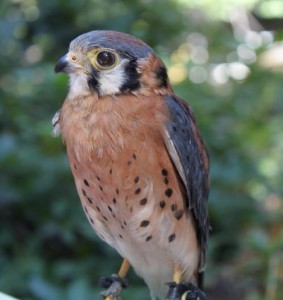 Common Raptors
Common Raptors
A bird of prey or raptor is a bird that hunts for food primarily using its talons. Their beak tip is curved and they have superb vision.
If you find an injured adult or young raptor, unable to fly, call WR&R immediately – 530-432-5522. Do not attempt to care for these delicate birds. They have very specific food and care requirements. Not only is it dangerous for the bird, it is illegal.
The following describes some of the raptors found in the foothills of Northern California.
Owls
Owls are variable-sized nocturnal hunting birds. They fly soundlessly and have very acute senses of hearing and sight. They are found in all regions of the Earth except Antarctica, most of Greenland, and some remote islands. Though owls are typically solitary, the literary collective noun for a group of owls is a parliament. Owls have large forward-facing eyes and ears, a hawk- like beak, and usually a conspicuous circle of feathers around each eye called a facial disc. Although owls have binocular vision, their large eyes are fixed in their sockets, as with other birds, and they must turn their entire head to change views. Owls are far-sighted and are unable to clearly see anything within a few inches of their eyes. Their far vision, particularly in low light, is exceptionally good. They can turn their head 135 degrees in either direction and thus look behind their own shoulders.
The Western Screech Owl
The Western Screech Owl is a small owl of the West and can be found in urban as well as wild lands. It is only 7-10 inches in size but has been known to capture prey larger than itself, including rabbits and ducks. Western Screech Owls are vulnerable to habitat loss because of urban development.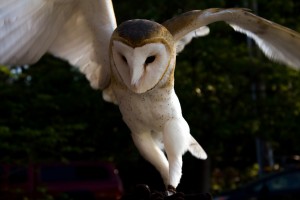 Barn Owl
Barn Owl
Barn owls are the most widespread of all owl species and are found on every continent except Antarctica. The barn owl’s face is arresting. There are no ear tufts. The eyes and beak are completely encircled by a heart-shaped facial ruff of white feathers that radiate out from the small, dark eyes. Barn Owls are more nocturnal than other owls. They wait until dark before venturing out to hunt, except when the demands of their young may start them hunting at twilight. Normally, before daylight, they retire to some shadowed or enclosed area in an old building, a hollow tree or a hole in a rocky cliff and remain there drowsily inactive all day.
When hunting at night, the Barn Owl sweeps the fields on silent wings catching its prey with its long, slender claws. It prefers small mammals but occasionally in winter, when mice and gophers are scarce, it will take small birds. The prey is torn apart and swallowed — bones, skull and all. The indigestible parts are formed into pellets and disgorged at the roosting area or about the nest.
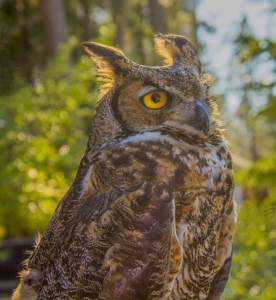 The Great Horned Owl
The Great Horned Owl
The Great Horned Owl is a very large owl native to North and South America. It is an adaptable bird with a vast range, though not as widespread as the Barn Owl. They have excellent hearing and exceptional vision in low light. Their hearing has better depth perception than human hearing and better perception of sound elevation (up-down direction). The latter is possible because owl ears are not placed in the same position on either side of their head: the right ear is typically set higher in the skull and at a slightly different angle. By tilting or turning its head until the sound is the same in each ear, an owl can pinpoint both the horizontal and vertical direction of a sound. The eyes of Great Horned Owls are also nearly as large as those of humans and are immobile within their sockets. Instead of turning their eyes, they turn their heads.
Their call is a low-pitched but loud “ho-ho-hoo hoo hoo”. Sometimes it is only four syllables instead of five. The female’s call is higher and rises in pitch at the end of the call. Young owls make hissing or screeching sounds that are often confused with the calls of Barn Owls.
Hawks
Hawks are medium-sized birds of prey. They are mainly woodland birds that hunt by sudden flights from a concealed perch. They usually have long tails. Hawks are widely reputed to have visual acuity several times that of a normal human being. This is due to the many photoreceptors in the retina (up to 1,000,000 per square mm for Buteo, against 200,000 for humans), an exceptional number of nerves connecting these receptors to the brain, and an indented fovea, which magnifies the central portion of the visual field.
The Red-tailed Hawk is a medium-sized bird of prey. Its preferred habitat is mixed forest and field, with high bluffs or trees that may be used as perch sites. However, it has adapted to the presence of man and can often be seen perching on highway utility poles. It can also be found in cities. The non- fiction book Red-Tails in Love: A Wildlife Drama in Central Park by Marie Winn made Pale Male, a Red-tailed Hawk in New York, the most famous urban red-tailed hawk. (Photo by Gary Yankech)
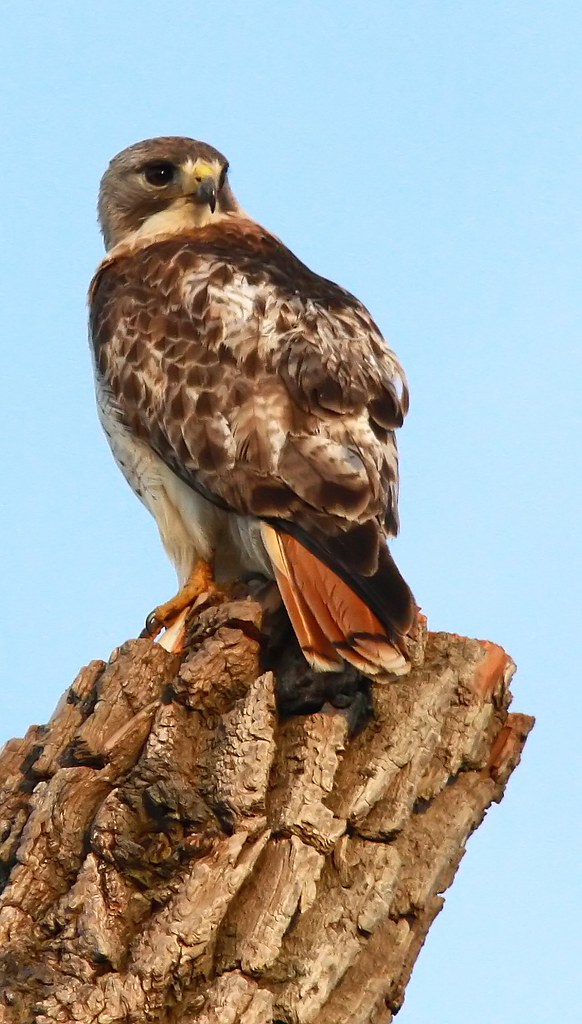 Red-tailed Hawk
Red-tailed Hawk
The Red-tailed Hawk is a medium-sized bird of prey. Its preferred habitat is mixed forest and field, with high bluffs or trees that may be used as perch sites. However, it has adapted to the presence of man and can often be seen perching on highway utility poles. It can also be found in cities. The non- fiction book Red-Tails in Love: A Wildlife Drama in Central Park by Marie Winn made Pale Male, a Red-tailed Hawk in New York, the most famous urban red-tailed hawk. (Photo by Gary Yankech)
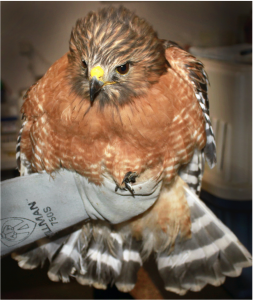 Red-shouldered Hawk
Red-shouldered Hawk
A common forest-dwelling hawk of the East and California, the Red- shouldered Hawk favors woodlands near water. It is perhaps the most vocal American hawk. It gets its name from the rusty red coloring on the upper part of its wing. In flight, rusty wing coverts contrast with black-and-white striped flight feathers.
Although the American Crow often mobs the Red-shouldered Hawk, sometimes the relationship is not so one-sided. They may chase each other and try to steal food from each other. They may also both attack a Great Horned Owl and join forces to chase the owl out of the hawk’s territory.
Peregrine Falcons are sleek, crow-sized birds of prey famous for their speed and beauty. They have a wingspan of 39-43 inches. Peregrine Falcons have one of the longest migrations of any North American bird. Tundra-nesting falcons winter in South America, and may move 15,500 miles in a year.
A peregrine hunts from the wing or from a high perch. It spots prey with keen eyes and begins its stoop, a streamlined dive with tail and wings folded and feet lying back. The falcon hits its prey with its foot, stunning or killing it, then swoops back around to catch it in mid-air. If the prey is too heavy to carry, the peregrine will let it fall to the ground and eat it there. Peregrines pluck their prey before eating it.
Falcons
Falcons are different from hawks and can be identified by their longer, more streamlined wings. They are powerful hunters and fast fliers. These birds use their notched beak to kill their prey unlike other birds of prey that use their feet. They have exceptional vision. The female falcons are larger than the male.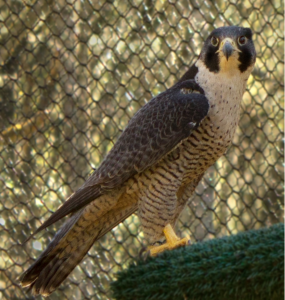 Peregrine Falcons
Peregrine Falcons
Peregrine Falcons are sleek, crow-sized birds of prey famous for their speed and beauty. They have a wingspan of 39-43 inches. Peregrine Falcons have one of the longest migrations of any North American bird. Tundra-nesting falcons winter in South America, and may move 15,500 miles in a year.
A peregrine hunts from the wing or from a high perch. It spots prey with keen eyes and begins its stoop, a streamlined dive with tail and wings folded and feet lying back. The falcon hits its prey with its foot, stunning or killing it, then swoops back around to catch it in mid-air. If the prey is too heavy to carry, the peregrine will let it fall to the ground and eat it there. Peregrines pluck their prey before eating it.
During a stoop, peregrines may reach speeds of 200 mph. The air pressure from this bullet-like plunge might burst an ordinary birds lungs. Its thought that the series of baffles in a peregrines nostrils slow the wind velocity, enabling the bird to breathe while diving. This magnificent bird almost became extinct because of the devastating effects of the pesticide DDT which caused eggshell thinning and breakage. In 1970, wildlife biologists knew of only two pairs of peregrine falcons nesting in California. Now, there are approximately 150 nesting pairs and an estimated total population in the state of about 750 birds, according to Brian Walton, coordinator of the Santa Cruz Predatory Bird Research Group (SCPBRG) at UC Santa Cruz.
Thanks to the elimination of most uses of DDT and population recovery through captive breeding, the species has recovered and has been removed from the federal endangered species list. However the state of California continues to list the peregrine as “endangered” until their numbers can increase to acceptable levels.
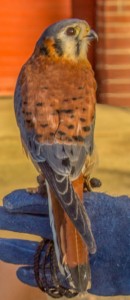 The American Kestrel
The American Kestrel
The American Kestrel is the smallest falcon in North America—about the size of an American Robin. It is the only one of the falcons that hovers over its intended prey.
